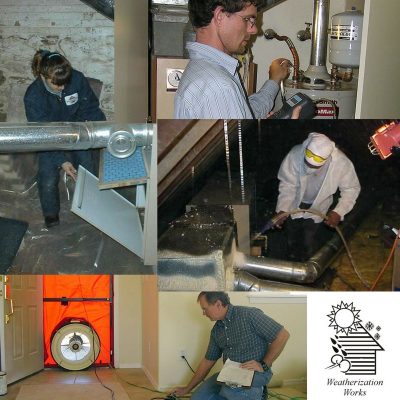Front Porch Blog
Fall is upon us! Its colorful foliage, shorter days, pumpkin-spice everything and crisp air remind us all that winter is just around the corner.
With the falling temperatures come higher heating costs. This is a problem for many folks nationwide and has been for decades, which is why 40 years ago the federal government launched the National Weatherization Assistance Program. That’s why Appalachian Voices celebrated National Weatherization Day on Oct. 30 — the 40th anniversary of the National Weatherization Assistance Program.
The Weatherization Assistance Program (WAP) was created 1976 by the Energy Conservation and Policy Act following the 1973 Oil Crisis when unemployment and energy costs were high. The purpose of the program is twofold: lower energy costs and increase health and safety for low-income families and, by making their homes more energy efficient, reduce dependency on foreign oil and reduce carbon emissions. Since President Jimmy Carter’s administration established WAP, more than 7.4 million homes have been weatherized through funds distributed to state and local agencies.
A 2008 retrospective study from Oak Ridge National Laboratory showed that — depending on the type of home, geographical location, and fuel type — weatherization can save families an average of $283 on annual energy costs. Weatherization not only makes your home more energy efficient, it can also have a positive impact on your health. The Oak Ridge study found that after weatherization, residents with asthma reported fewer hospitalizations and emergency room trips.
It is hard to argue the benefits of WAP, but budget cuts to programs like WAP and the Low Income Home Energy Assistance Program, combined with cost of living increases and stagnant wages, mean that the need for weatherization far exceeds the capacity and resources available through WAP. Many families, especially in the Southeast, are facing another winter of high energy costs and difficulty keeping their homes warm and comfortable. An analysis of home energy efficiency in the United Stated by WalletHub found that all but one of the 10 least energy-efficient states are in the Southeast. Virginia, West Virginia, North Carolina, Tennessee and Kentucky all ranked in the bottom fifteen.
National Weatherization Day was Oct. 30, but that doesn’t mean you can’t celebrate all year long. You can contact your local WAP provider or utility to see what programs they offer. But you don’t have to participate in the WAP program to weatherize your home. Here are a few other ideas.
First, take an afternoon to complete some DIY no- or low-cost weatherization improvements (use our handy checklist). Or, if you know a neighbor or community member who might not be able to complete the DIY weatherization improvements themselves, get a couple friends together and see if you can help them caulk their windows or add weatherstripping around their doors.
Here are just a few ways you can save money and make a home more comfortable this winter.
1. Caulk around your windows making sure there are no gaps for air to escape or come in through.
2. Put weatherstripping around the doors leading outside. As older homes settle it is common for gaps to appear between the doors and their frame. If you can see light it’s not airtight!
3. Turn the temperature on your water heater down to 120 degrees. Every 10 degree reduction is 3-5 percent off your water heating cost.
4. Can’t replace your window? Try putting plastic over them or hanging heavy curtains to block the cold air.
5. Only run electric heaters when you are in the room, turn them off when you leave.
For more no- and low-cost improvements, or to see video demonstrations, visit appvoices.org/energysavings/tips/. And show us how you are preparing your house for winter by using the hashtags #weatherizationworks and #saveenergyappalachia.
PREVIOUS
NEXT

Leave a comment
Your email address will not be published. Required fields are marked *


Leave a Comment